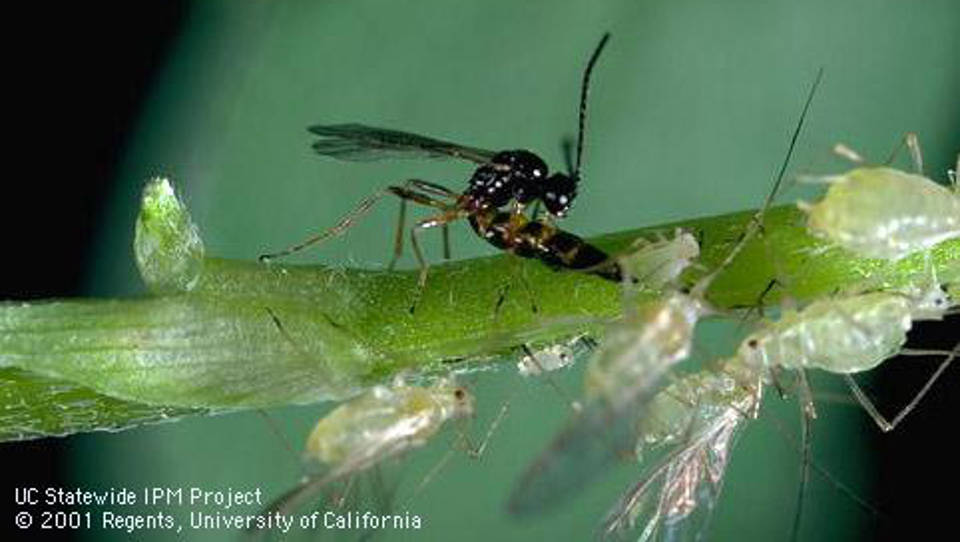Parasitic wasp aphid control is one of our favorite organic pest control methods to use in the garden. These small wasps are harmless to humans and are incredibly effective for aphid control. Last week we discussed ladybugs for pest control and today we will meet Aphidius Colemani and Aphidius Ervi in our latest high performance garden training video. Learn how to use parasitic wasp aphid control in your garden with Lynn as she releases our “waspy buddies” in our greenhouses.
Using the Aphidius in your garden will keep your garden in harmony with nature; because you will not be spraying pesticides in your garden. I call these parasitic wasps my “waspy buddies” because of how incredible they can be in your garden!

Jack Kelly Clark, courtesy University of California Statewide IPM Program.”
Scientific Name: Aphidius Colemani & Aphidius Ervi
Region: Aphidius Colemani are native to North America and Aphidius Ervi are native to Europe.
Lifecycle: The Aphidius hunts for individual aphids throughout the crop. The parasitic wasp finds aphid colonies from a long distance by “alarm signals” produced by an infected plant. At shorter distance it smells the honeydew. The adult Aphidius feeds on honeydew. When the wasp is ready to lay eggs she finds a host aphid to deposit one egg in each aphid. One female Aphidius can deposit an egg in up to 300 aphids in its 2-3 weeks as an adult. The wasp pierces the back of the aphid with its ovipositor, leaving a small, barely visible reddish mark. She then lays an egg in the aphid which, upon hatching, feeds without affecting the aphid at first. From within the aphid, the wasp larva will cut a small hole in the aphid and glue it to a leaf with a silk. Then the wasp larva will spin a cocoon around the aphid body. The Larva will pupate inside of the aphid. At this stage, parasitized aphids can easily be recognized as swollen, papery, and a silvery brown colored – also called a mummy. When the wasp is mature, it will cut a circular hole in the skin of the now dead aphid, and emerge as a winged adult.
The life cycle of Aphidius Ervi is longer than that of Aphidius Colemani. At the same temperature of 21°C the Colemani reaches maturity by 14 days while the Aphidius Ervi takes nearly 19 days. At 15°C, the duration of the cycle is approximately 20 days for Aphidius colemani, while it is nearly 29 days for A. ervi.

Where to Buy?
We buy the Colemani and the Ervi because they will both eat the different sized aphids that invade our gardens. The Ervi is the larger wasp from Europe and will prefer the large red aphids. Our native Colemani prefers the small green aphids. Our preferred place for ordering both ladybugs and Aphidius is the online Hydro Gardens store.
How Many & When to Release
Aphidius are better predators in a greenhouse versus being released out in the open. If you are going to use these in your garden I would suggest 250 per 100 square feet. Parasitic wasp control should be used to break the cycle of aphids in your garden alongside ladybugs. Make sure you order the correct wasp according to the aphids in your garden!
Are you tired of the traditional row garden system? To take control of your garden’s health to better deter pests it just might be time to invest in a high performance garden system. The ebook High Performance Gardening is the perfect place to start.
Enjoy a pest free garden!
Lynn Gillespie
Email Lynn any questions you have about beneficial insects or any type of gardening question. She would love to help you achieve the high performance garden of your dreams!









Do these particular wasps lay eggs in any other species, such as monarch caterpillars?
Not that I’m aware of.
I have a cherry tree that is being destroyed by black cherry bugs. We have used commercial sprays, but the effects do not last—- quite apart from us hating the general toxicity of the products. Would parasitic wasps do the job? We live in Northern Spain, so would you have any idea where I might be able to get some????
Yes they would work because those are a variety of aphids. I would just google where to find them in your country.